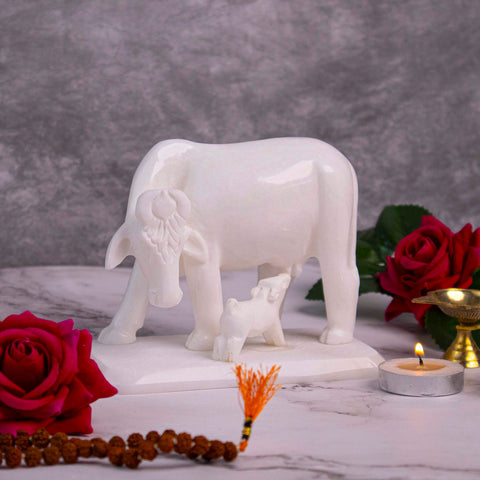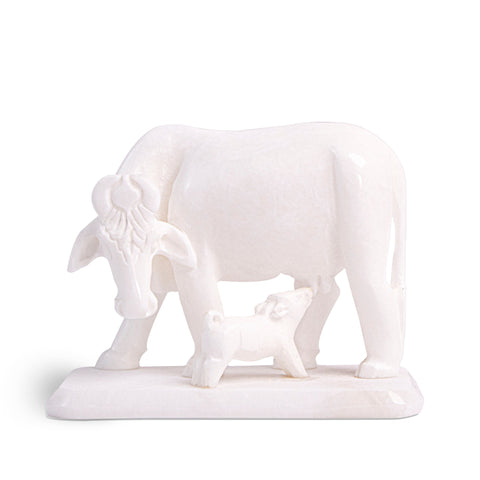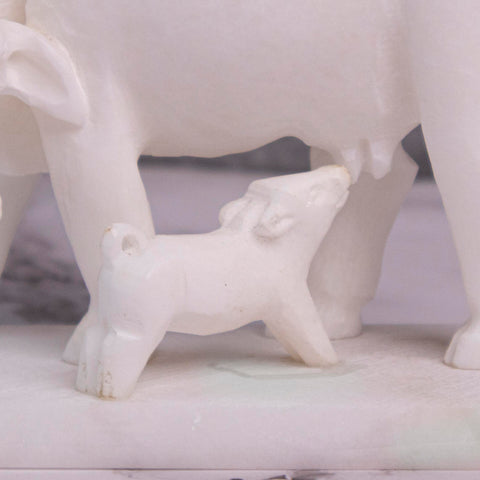All India Delivery
All India Delivery

In the beautiful collection of cultural traditions and spiritual customs, having a marble cow and calf statue at home is like a special thread that carries deep meanings and beliefs. This old Hindu practice reflects important values like caring, having plenty, and being pure. In this blog, we will explore why this practice matters so much, uncovering the special meanings it brings to homes both spiritually and culturally.
At the heart of this practice lies the reverence for the cow, often personified as "Kamadhenu," the wish-fulfilling divine cow. In Hindu culture, the cow symbolizes virtues like compassion, selflessness, and nurturing care. Its role in providing milk, a vital source of sustenance, endows it with a maternal quality, and its dung and urine are utilized in various purification rituals. The cow, beyond being a source of sustenance, represents the quintessential embodiment of abundance and purity.
Hindu mythology weaves a rich tapestry of deities and celestial beings closely associated with cows. Lord Krishna, the divine cowherd, is often depicted in the company of cows, and his interactions with them are cherished. These interactions convey a sense of intimate connection between humans, divinity, and the bovine. Goddess Lakshmi, the bestower of wealth and prosperity, is believed to reside where the cow is venerated. By welcoming a cow and calf idol into homes, devotees extend their reverence to these deities, seeking their blessings.
The image of a cow nurturing its calf evokes emotions of care, protection, and love. By having a cow and calf idol gracing their abode, individuals aim to infuse their living space with these qualities. The cow and calf marble statue acts as a constant reminder to foster relationships, exhibit compassion, and create an atmosphere of abundance. The symbolism resonates with the principle of giving selflessly and receiving bountifully, fostering an environment of harmony and positivity.

Vastu Shastra, the ancient Indian architectural science, emphasizes the influence of spatial arrangement on energies. Placing a cow and calf idol in specific areas of the house is believed to balance these energies and invite harmony. The presence of the idol is thought to channel positive vibrations, enhance the flow of energy, and contribute to a tranquil atmosphere. This practice aligns with the fundamental Hindu principle of harmony between the physical and spiritual realms.
For families with children, a cow and calf idol can serve as a powerful tool for imparting cultural and moral values. Parents can utilize the symbolism of nurturing, protection, and respect for all life forms to instill essential life lessons in their children. This practice bridges generations, ensuring that profound values are passed down, enriching the spiritual fabric of the family.
The practice of keeping a cow and calf idol at home transcends the spiritual realm and extends to environmental consciousness. Cows play a pivotal role in sustainable agriculture through their contribution to organic farming practices. Additionally, they are adept at recycling waste into useful products, showcasing their essential role in maintaining ecological balance.
Embracing the presence of a cow and calf idol foster's daily rituals of devotion. Lighting incense, offering flowers, and engaging in prayers create a sacred routine that connects individuals with their inner selves and the divine. These rituals cultivate mindfulness, spirituality, and a sense of gratitude, allowing individuals to navigate the challenges of life with a centered spirit.
Conclusion: Embracing the Divine Presence
In essence, the practice of keeping a cow and calf idol at home goes beyond religious dogma, radiating a universal message of nurturing, abundance, and interconnectedness. It speaks to the human longing for deeper meanings and connections in a world often dominated by material pursuits. This tradition envelops households in an aura of compassion, gratitude, and humility, enriching their spiritual and cultural tapestry. By inviting the divine presence of the cow and calf into their homes, individuals create a harmonious environment resonating with positivity, prosperity, and profound spiritual growth.
In the world of Vastu Shastra, the ancient Indian science of architecture and design, every aspect of a living space is believed to influence the energies that flow through it. Among the many elements that hold significant Vastu importance, the presence of a cow and calf statue in your home can have a profound impact on the energy balance, fostering harmony, abundance, and positivity. In this blog, we will explore the Vastu significance of cow and calf marble statues at home and how they can contribute to your overall well-being.

The kamdhenu cow with calf duo holds deep symbolism in various cultures, representing nurturing, care, and abundance. In Hinduism, the cow is revered as a sacred animal, and its maternal instincts towards its calf highlight qualities of selflessness and protection. By placing a cow and calf statue in your home, you invite these qualities into your living space, creating an environment that resonates with care, compassion, and prosperity.
According to Vastu principles, every object and arrangement in your home can influence the flow of energy, or "prana." The cow and calf statue, when strategically placed, is believed to channel positive energy throughout your home. Placing it in the north or east direction is recommended, as these directions are associated with abundance, growth, and positive vibrations. This arrangement can help amplify the auspicious energy that the statue represents.
Vastu emphasizes the balance of the five elements—earth, water, fire, air, and space—in your living space. The cow represents the earth element, while the calf symbolizes the bond between mother and child. This balance of elements is essential for a harmonious atmosphere. When you incorporate a marble cow and calf statue, you enhance the grounding and stabilizing qualities of your home, fostering a sense of rootedness and tranquility.
Goddess Lakshmi, the embodiment of wealth and prosperity, is often depicted with cows by her side. The presence of a cow and calf statue is believed to attract the blessings of Goddess Lakshmi, ushering in wealth and abundance. Placing the statue in the southeast corner, associated with the fire element and wealth, can enhance its effects on your financial well-being.
The image of a mother cow nurturing her calf signifies strong family bonds and care. Placing a cow and calf statue in the family or living room can strengthen the emotional connections within your family. It serves as a visual reminder of the importance of unity, support, and nurturing love, fostering a harmonious atmosphere for all family members.

Apart from its material benefits, a cow and calf statue also holds spiritual significance. Engaging in daily rituals, such as lighting a lamp or offering a flower, can create a sacred routine that uplifts your spiritual well-being. The presence of the statue serves as a focal point for meditation and introspection, allowing you to connect with deeper aspects of your inner self.
When selecting a cow and calf statue, consider the material, size, and craftsmanship. Opt for high-quality materials like marble, as they hold positive energies more effectively. Additionally, choose a size that complements your living space without overwhelming it. Intricate detailing in the craftsmanship can enhance the aesthetic appeal and energetic resonance of the statue.
Conclusion: Creating an Auspicious Home Sanctuary
Incorporating a cow and calf statue into your home decor is more than just a decorative element; it's a way of aligning your living space with positive energies and ancient wisdom. By understanding the Vastu significance and strategically placing the statue, you can create a home sanctuary that nurtures your physical, emotional, and spiritual well-being. Embrace the symbolism of care, abundance, and unity that the cow and calf represent, and watch as your living space transforms into a haven of harmony and prosperity.
Leave a comment